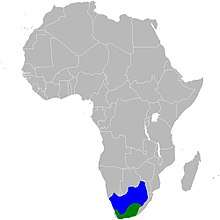Fairy flycatcher
The fairy flycatcher or fairy warbler (Stenostira scita) is a small passerine bird. Formerly placed in the Old World flycatcher family, Muscicapidae, it is now separated with some other "odd flycatchers" as the new family Stenostiridae (Beresford et al. 2005, Fuchs et al. 2006). It is the only member of the genus Stenostira.
| Fairy flycatcher | |
|---|---|
.jpg) | |
| Scientific classification | |
| Kingdom: | Animalia |
| Phylum: | Chordata |
| Class: | Aves |
| Order: | Passeriformes |
| Family: | Stenostiridae |
| Genus: | Stenostira Cabanis & Bonaparte, 1850 |
| Species: | S. scita |
| Binomial name | |
| Stenostira scita (Vieillot, 1818) | |
 | |
| Range map Resident year-round range Non-breeding winter visitor range | |
| Synonyms | |
|
Muscicapa scita Vieillot, 1818 | |
It is an endemic resident breeder in southern Africa in Botswana, South Africa, Lesotho and Namibia, and a vagrant to Zimbabwe and Swaziland.
Stenostira scita is a common seasonal migrant, breeding in karoo scrub and fynbos in the southern highlands, and migrating north in to spend the southern winter in thorn scrub at lower altitudes.
Description
The fairy flycatcher is 11–12 cm in length. The adult is pale grey above with a black mask through the eye and a white supercilium. The wings are black with a long white stripe, and the long black tail has white sides. The throat is white, the breast is pale grey, and the belly is white with a pinkish-grey wash to its centre. The sexes are alike, but the juvenile is browner than the adult. The eye is brown and the bill and legs are black.
Behaviour
The fairy flycatcher is monogamous unless its mate dies, when it will seek a new partner. It builds an open cup nest from thin stems and other plant material and lined with plant down. It is placed in the branches of a tree or shrub but well concealed. The female lays two or three green eggs.[2]
This bird is usually seen alone, in pairs, or small flocks. It feeds on small insects and other invertebrates, foraging in the foliage like a warbler.
References
- BirdLife International (2012). "Stenostira scita". IUCN Red List of Threatened Species. 2012. Retrieved 26 November 2013.CS1 maint: ref=harv (link)
- James, H. W. (1922). "Notes on the Nest and Eggs of Stenostira scita (Vieill)". Ibis. 64: 254–256. doi:10.1111/j.1474-919X.1922.tb01316.x.
- Barker F. Keith, Cibois Alice, Schikler Peter A., Feinstein Julie, Cracraft Joel (2004). "Phylogeny and diversification of the largest avian radiation". PNAS. 101 (30): 11040–11045. doi:10.1073/pnas.0401892101. PMC 503738. PMID 15263073.CS1 maint: multiple names: authors list (link) Supporting information
- del Hoyo, J.; Elliot, A. & Christie D. (editors). (2006). Handbook of the Birds of the World. Volume 12: Picathartes to Tits and Chickadees. Lynx Edicions. ISBN 9788496553422
- Fuchs J., Fjeldså J., Bowie R. C. K., Voelker G., Pasquet E. (2006). "The African warbler genus Hyliota as a lost lineage in the oscine songbird tree: Molecular support for an African origin of the Passerida". Molecular Phylogenetics and Evolution. 39 (1): 186–197. doi:10.1016/j.ympev.2005.07.020. PMID 16182572.CS1 maint: multiple names: authors list (link)
- Sinclair, Ian; Hockey, Phil & Tarboton, Warwick R. (2002): SASOL Birds of Southern Africa. Struik, Cape Town ISBN 1-86872-721-1
